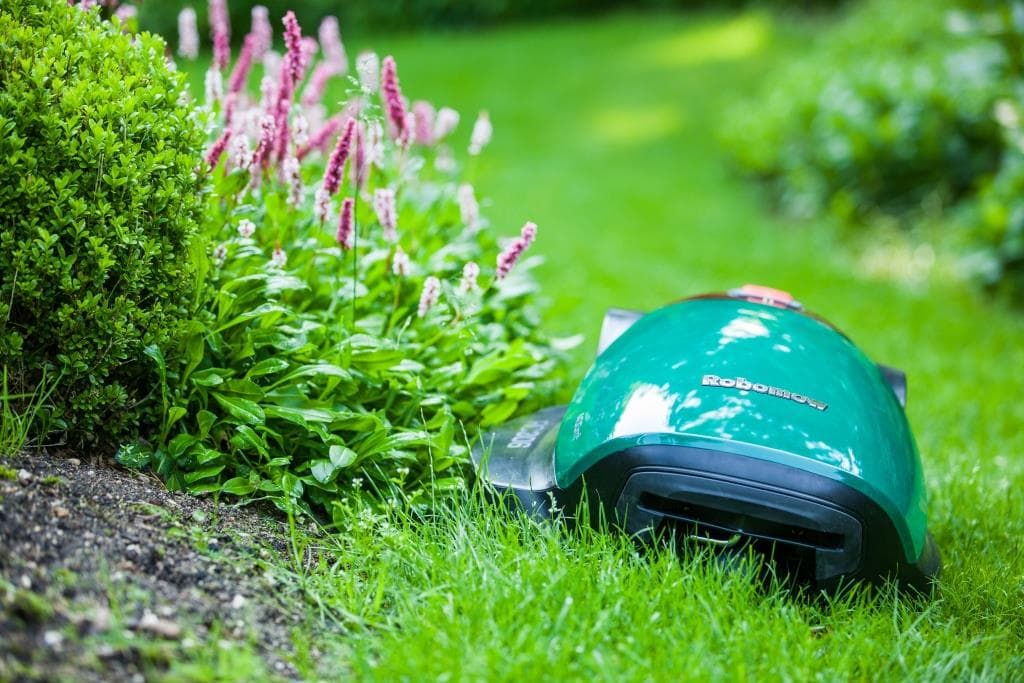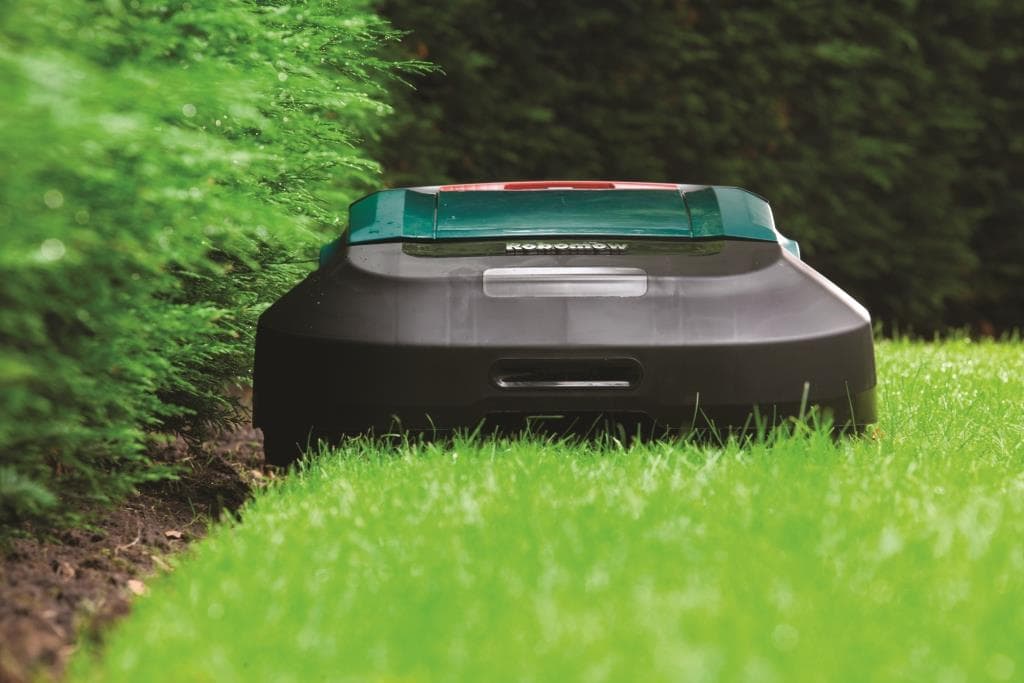Which lawn edging is suitable for robotic mowers?
03.05.2023
With an autonomous robotic mower, the effort that goes into lawn care is significantly reduced when compared to a non-autonomous mower. Often, however, the edges of the lawn may still be left tall, as the robot simply cannot reach the outermost edge due to its design. Thereby, manually trimming is usually the only solution. Unless, of course, the lawn border is specially designed for a robotic mower.
A robotic lawnmower is normally purchased because people want more freedom to enjoy the beauty of their garden. That’s when the robot lawnmower steps up. It gives an excellent, level cut, while providing essential nutrients to maintain a healthy lawn. Unfortunately, sometimes pesky edges are impossible to reach if the layout of the lawn is not specifically designed for your little helper. Thankfully, there are special lawn borders that are well suited for robotic mowers.
CONSTRUCTION OF THE ROBOTIC MOWER
The blades of the robotic lawnmower are usually located centrally under the device or on the sides with models that come equipped with an edge trimming function. For safety reasons, the blades of both models do not reach the outer edge of the housing, but have a distance of between 6 cm (the edge-cutting function model) and 20 cm. This means the blades do not reach the lawn’s edge even if the device runs with the housing directly along a wall or standing barrier.
The situation is different for lawn edges that are at ground level and can be driven over by the robotic lawnmower (e.g. paths whose upper edge ends at the level of the turf or with special lawn borders with beds).
WHY DO YOU NEED A LAWN BORDER?
Lawn borders make perfect sense. Without barriers, lawns tend to spread , growing into beds or spreading further and further in the joints of paths. A lawn border can at least contain the growth.
SUITABLE LAWN BORDERS FOR ROBOTIC MOWERS
A lawn border that is specially adapted to the operating behavior of your robotic mower canl save you a lot of work and maintenance on lawn edges. The trick is to create a level border that is just wide enough for the robotic lawnmower to drive over and span the outermost edges with its blades. This is particularly easy when the garden is just being planned, but it can also be done at a later time.
We recommend the following: first measure the distance between the perimeter wire and the lawn clippings to determine the distance from walls or fences you need to be. How wide the lawn boundary ultimately has to be for the robotic lawnmower to completely cover the edge depends primarily on the distance between the outer edge of the blades and the housing. This can be easily determined by the following calculation: (width of the body minus the diameter of the blade or blade disc x (times) 2).
METAL AND PLASTIC LAWN EDGES
We do not recommend lawn edges made of metal since they are not suitable for robotic lawnmowers. Although these are particularly discreet and have a noble effect, especially on curved lawn edges, they can severely interfere with the robot's signal and have a negative effect on its driving behavior.
On the other hand, lawn edges made of plastic or rubber are not usually level, so the robot cannot simply drive over them. This may require retouching with the lawn trimmer.
If you are set on using plastic for your lawn edges, be sure the edges are at ground level and place the perimeter wire so that the robot mows up to the outer lawn edge (i.e. over the edging). Beds should be the same height as the surface of the lawn but not planted to the outer edge.
CONCRETE OR NATURAL STONE LAWN EDGING STONES
The most suitable lawn edging stones are those with a smooth surface. Concrete stones or the so-called dovetails work well. Granite stones tend to be popular as well. Rough hewn stones tend to give the robot a bumpy ride, which either leads to it bouncing over an edge or an uneven cut. However, stability during operation can be assisted by fitting the mower with coarse, off-road wheels. This will also lead to a smooth drive.
To help prevent weeds from sprouting up, it is advisable to lay lawn edging stones in two rows with staggered joints. Whether laid in one or two rows, a bit of work is necessary, though. To ensure that the stones end up lying flat with the ground, you should first dig a trench and fill it in with a layer of sand to help embed the stones.
Laying stone or concrete lawn edging
Laying stones is quite time-consuming, as a small trench must first be dug to help the stones lie level in the end. Before laying the stones, it is recommended to put a layer of sand in the trench.
In principle, it is also possible to lay the boundary wire in the trench. Follow the maximum depth recommended by the manufacturer. Be that as it may, if there is a defect or cable break, the repair is comparatively costly.
WOODEN LAWN EDGING
Wooden lawn edgings looks more natural than lawn stones or concrete. Unfortunately, wood is somewhat less weather-resistant but can be laid much faster. Basically, it is sufficient to lay planks parallel to the lawn edges and straighten them accordingly so they do not sink or slip on the ground. Keep in mind that wood tends to warp creating uneven surfaces, so retouching is inevitable.
ENGLISH LAWN EDGING
English lawn edges are particularly elegant. They are characterized by their naturalness, as the lawn edge is cut at regular intervals. However, this is usually accompanied by a small slope between the lawn edge and a bed. If the perimeter wire is too close to this difference in height, the robotic lawnmower runs the risk of getting stuck on the incline or trimming the lawn edge unevenly. Accordingly, this type of lawn edging is not optimal for use with robotic mowers.
PLUG-IN SYSTEMS MADE OF SPECIAL METALS
It is particularly easy to install plug-in systems made of metal sheets, which the robotic lawnmower can easily traverse. Moreover, the copper provides effective protection against snails. Depending on the product, a rust patina is formed over time creating a great effect in your garden. When choosing a suitable metal, make sure that it does not limit the functionality of the robotic lawnmower by interfering with signals.
NATURAL LAWN BORDERS
When forming borders for your lawn, you do not need to use plastic, stone slabs, or wooden slats by any means. It is also possible to use wood chips or small lava stones. Both materials can be backfilled in a small trench similar to lawn edging stones. Nonetheless, both materials affect the soil: wood chips remove nitrogen from the soil and lava stones increases soil acidity. Therefore, we recommend taking countermeasures.
LAYING THE BOUNDARY WIRE AT THE LAWN BORDER
The robotic lawnmower usually extends slightly beyond the perimeter wire so it’s important not to lay the wire exactly to the outer edge of the lawn but always with a small distance to the inside. This varies depending on whether the robotic lawnmower has an edge cutting function and whether the lawn is bordered by a wall, pond or bed.
For example, if a bed is planted to the very edge, the distance should be slightly greater than for beds that have a natural finish with mulch.
THE CORRECT WIDTH OF LAWN EDGING STONES
The correct width of the lawn edging stones depends on what lies behind them. Is it the wall of the house, a pond, or a flower bed? If the stones are set at ground level with some space between a barrier, its width may be less than with stones directly against a wall.
Here it is important to prevent the robotic lawnmower from dragging along the wall of the house. Often 10 cm is sufficient, while stones that butt up against a wall should have a width of 20 cm or more.
Robotic mowers with three wheels have a higher risk of getting stuck, especially if the front wheel goes beyond a lawn boundary. With such models, the boundary should be selected so that the front wheel always remains on a paved surface.

ADDITIONAL BOUNDARY STONES
As a rule, the robotic lawnmower should not drive over the boundary wire. Despite that, there are situations in which the device will not stop in time. If the embankment is followed by a garden pond, there is the risk of the robotic lawnmower landing in it.
At such potentially dangerous areas, lawn borders that protrude a few centimeters above the ground are suitable to help stop the robotic lawnmower's movement.
THE ALTERNATIVE: ROBOTIC MOWERS WITH EDGE-CUTTING FUNCTION
Blades on most robotic mowers are mounted centrally under the device. That means the robot blade cannot reach the outer strip between the device and the edge of the lawn. On the other hand, blades on robots with an edge cutting function are mounted laterally allowing for the blades to protrude beyond the wheelbase. This strip is significantly smaller but does exist. The lawn edges along fences and walls is thus minimal, leaving trimming hardly worth it.
If you still want a clean finish, simply place an additional row of lawn edging stones along the lawn edge. The robotic lawnmower will be able to drive over one side while mowing the last bit.
FURTHER TIPS FOR ROBOT-FRIENDLY LAWN EDGES
- The angles of lawn edges should not be smaller than 90°. This either leads to time-consuming turning maneuvers or the robotic lawnmower will not be able to reach the corner. Therefore, rounded edges are much more suitable.
- Do not plan lawn edges where the perimeter wire is well under a meter apart. Such narrow passages often lead to confusion during navigation.
LAWN BOUNDARIES FOR ROBOTIC MOWERS WITH GRASS SENSORS
Unlike robotic lawnmowers with boundary wires, robotic lawnmowers with grass sensors navigate on the basis of surface structures and mow all areas that look like lawns. Accordingly, a lawn border that is visually distinct from the lawn is important. In most cases, a natural barrier is advantageous, which mechanically prevents the robotic lawnmower from moving on and does not rely on a sensor. Otherwise, the robotic lawnmower would threaten to trim the ground cover in the bed, for example.
Consequently, robotic mowers with grass sensors often leave lawn edges that require manual retouching with the trimmer.
ALTERNATIVE: TRIMMING LAWN EDGES
Even with a well-thought-out garden design, a robotic lawnmower may not reach certain corners and edges. In this case, only manual retouching with a lawn trimmer or shears can do the trick. Which garden tool is best suited here depends on the size of the garden and the length of the lawn edges. Mechanical shears are well suited for small areas, while when trimming several lawn edges, battery-powered devices are a good choice.
If you do not want to have to use a lawn mower or a trimmer to achieve a perfect lawn, we recommend a garden design in which the lawn edges are robotic lawnmower friendly. Ground-level lawn borders made of stone or concrete, which the robotic lawnmower can simply drive over, have proved particularly effective in this respect. Alternatively, wooden planks do not fail to have an effect, but they look more rustic and are less weather-resistant at the same time. This may involve a bit of work at first but should save you a lot of time in future.
Products
Buy a Robomow
Robomow owner
About us
Sales & Support
